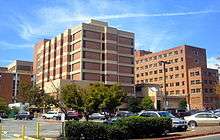MedStar Georgetown University Hospital
| MedStar Georgetown University Hospital | |
|---|---|
| MedStar Health | |
|
| |
| Geography | |
| Location | 3800 Reservoir Road NW, Washington, D.C., United States |
| Organization | |
| Care system | Private not-for-profit |
| Hospital type | Academic Teaching Hospital |
| Affiliated university | Georgetown University School of Medicine |
| Services | |
| Beds | 609 |
| History | |
| Founded | 1898 |
| Links | |
| Website |
www |
| Lists | Hospitals in Washington, D.C. |
Coordinates: 38°54′42″N 77°4′32″W / 38.91167°N 77.07556°W MedStar Georgetown University Hospital is one of the national capital area's oldest[1] academic teaching hospitals and is affiliated with Georgetown University School of Medicine. MedStar Georgetown is a not-for-profit, acute-care teaching and research facility located in Northwest Washington, DC. MedStar Georgetown’s clinical services represent one of the largest, most geographically diverse, and fully integrated healthcare and delivery networks in the area. MedStar Georgetown is home to the internationally known Lombardi Comprehensive Cancer Center, as well as centers of excellence in the neurology, neurosurgery, psychiatry, gastroenterology, transplant and vascular surgery. It is located in the Georgetown neighborhood of Washington DC.
The hospital has 609 licensed beds and employs over 4,000 personnel.[2][3]
History

Georgetown University Hospital was founded in 1898 as part of Georgetown University. The facility opened with 33 beds and was staffed by the Sisters of St. Francis.[4] The Hospital moved to its current location on Reservoir Road NW in 1930.
In the past century the hospital has grown to include a community physician practice, the Lombardi Cancer Center and scores of clinical departments and divisions. Through its 100-year relationship with Georgetown University, the hospital collaborates in training students from both the School of Medicine (almost 500 residents and fellows annually) and the School of Nursing & Health Studies. Additionally, MedStar Georgetown University Hospital works closely with the university's research enterprise to help bring innovative therapies from the scientific laboratory to the patient bedside. The Main Hospital was built in 1947 and was the first building erected in what is now the MedStar Georgetown University Hospital complex. The hospital, now more than 80 percent renovated, houses multiple patient units, hospital administration offices, and hospital support services. In July 2000, Georgetown University entered into a partnership with Medstar Health, a not-for-profit organization of two other Washington hospitals and five Baltimore hospitals- including another Catholic hospital. This partnership greatly improves the clinical efficiency and increases the diversity of clinical experiences available to students. The new Georgetown/Medstar partnership remains committed to the Catholic Jesuit ideals of care for the whole patient and service to those less fortunate. As the School of Medicine enters its 150th Anniversary year, the hospital has just completed its centennial celebration [5] With primary care providers at nine sites in Washington, D.C., Maryland and Virginia, MedStar Georgetown University Hospital's clinical services represent one of the largest, most geographically diverse and fully integrated healthcare delivery networks in the area.[1] M. Joy Drass, MD, an alumna of Georgetown University School of Medicine, was appointed President of MedStar Georgetown University Hospital in October, 2000 and continues to lead the hospital today.[6]
The hospital was ranked in 13 specialty areas in 2001 U.S. News & World Report's "Best Hospitals" issue. MedStar Georgetown was ranked in more categories than any other Washington-area hospital was awarded Magnet Status by the American Nurses Credentialing Center (ANCC) in 2004. MedStar Georgetown was the first, and remains the only, hospital in the District to be awarded this distinction.[7]
Current operations

The research and education programs affiliated with MedStar Georgetown University Hospital continue to be administered by Georgetown University Medical Center. These include the residency and fellowship programs, as well as clinical trials.
Some of the specialty areas in which it has been ranked among the top hospitals in recent years include cancer, digestive disorders, ear-nose and throat, geriatrics, gynecology, heart disease, hormonal disorders, kidney disease, neurology, neuro-surgery, psychiatry, respiratory disorders, rheumatology, urology, gastroenterology and orthopaedics.[8] The Lombardi Comprehensive Care Center is the only facility in the Washington, D.C. area designated by the National Cancer Institute (NCI) as a Comprehensive Care Center. MedStar Georgetown's Transplant Institute is ranked among the best in the mid-Atlantic region by the Scientific Registry of Transplant Recipients for liver transplant outcomes and is one of few centers in the country to provide living-donor liver transplants. Georgetown Neurosciences is the first on the East Coast and the sixth in the nation to offer the CyberKnife, the latest in stereotactic radiosurgery to treat tumors and lesions of the brain, neck and spine.
Additionally, MedStar Georgetown is home to the Lombardi Comprehensive Cancer Center, the only facility in the Washington, D.C. area designated by the National Cancer Institute (NCI) as a Comprehensive Cancer Center.[9] In 2000, Georgetown University Hospital became part of MedStar Health, a non–profit network of seven regional hospitals, which together see more than 7000 new cancer patients annually. The Lombardi MedStar Research Network has been a great success, both with increased accrual to clinical trials and increased Cancer Center membership. In 2007, over 200 patients were accrued to therapeutic trials.[10]
Deaths
- Paulina Longworth Sturm (1925–1957)[11]
- Bertram Dalley Tallamy (1901–1989).[12]
- Thomas McPherson Brown (1906–1989), Professor of Medicine at George Washington School of Medicine in Washington D.C.; Department Chairman at the same university
References
- 1 2 "Our Hospital - MedStar Georgetown University Hospital".
- ↑ MedStar-Georgetown Med Ctr: Hospitals Directory – US News Health
- ↑ "Newsroom - MedStar Georgetown University Hospital".
- ↑ Historic Medical Sites in the Washington, DC Area from the National Library of Medicine
- ↑ http://som.georgetown.edu/prospectivestudents/prospectus/46024.html
- ↑ Bhambhani, Dipka (October 2, 2000), "Ex-student returns to head GU hospital", Washington Times, pp. D19
- ↑ ANCC Magnet-Designated Facilities in Washington, DC
- ↑ "Centers of Excellence - MedStar Georgetown".
- ↑ NCI list of designated cancer centers in Washington, DC
- ↑ http://cancercenters.cancer.gov/cancer_centers/lccc.html
- ↑ Washington Post archive
- ↑ Alfonso A. Narvaez (September 19, 1989). "Bertram D. Tallamy, 87, Official For U.S. and New York Highways". New York Times. Retrieved 2011-11-14.
Bertram Dalley Tallamy … died of kidney failure Thursday at Georgetown University Hospital in Washington. …
External links
| Wikimedia Commons has media related to Georgetown University Hospital. |
